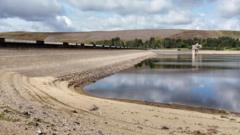Why Are Experts Concerned About Scotland's Water Supplies Despite Its Rain?

Published: 2025-08-25 12:35:51 | Category: technology
Scotland is currently facing a significant water scarcity crisis after experiencing the driest spring since 1964, compounded by a hot summer. Water levels are alarmingly low, particularly in the east, prompting the Scottish Environment Protection Agency (SEPA) to impose restrictions on water abstraction from certain rivers. These measures aim to protect the vital water resources needed for both agriculture and industry, as prolonged dry spells threaten future water supplies.
Last updated: 27 October 2023 (BST)
Key Takeaways
- Scotland is experiencing its driest conditions since 1964, leading to significant water shortages.
- SEPA has introduced restrictions on water abstraction in the Ythan and North Fife catchment areas.
- Water levels in eastern reservoirs are critically low, with some reservoirs at less than half capacity.
- Scottish Water is exploring temporary solutions to bolster water supplies, including moving water from wetter areas.
- Climate change is impacting rainfall patterns, causing extreme swings between droughts and floods.
Understanding the Current Water Crisis in Scotland
Scotland is often characterised by its lush landscapes and frequent rainfall, but 2023 has proved that this image can be misleading. The combination of a record dry spring and an unusually warm summer has led to a situation where water levels are significantly below normal. This has raised concerns about water availability for drinking, agriculture, and industry, particularly in the eastern regions of the country.
SEPA's Response to Water Scarcity
The Scottish Environment Protection Agency (SEPA) has reacted to the alarming situation by declaring significant scarcity levels in two critical catchment areas: Ythan in Aberdeenshire and North Fife. This classification indicates that river levels have been critically low for over 30 days, necessitating immediate restrictions on water abstraction—the process of extracting water from natural sources for various uses.
Impacts on Reservoirs and Water Supply
With the ongoing dry spell, water supplies are under immense pressure. For instance, the Backwater Reservoir in Angus, which services around 300,000 people, is currently less than half full. This poses a serious risk to drinking water availability as demand has surged by 100 million litres per day during the summer heat.
Scottish Water is considering implementing a temporary network to move water from the River Isla into Backwater Reservoir. Such a plan would require SEPA's approval to ensure environmental integrity is maintained. Meanwhile, Kirriemuir has already resorted to tanker deliveries to top up its water supply, highlighting the growing challenges faced by communities reliant on these systems.
Regional Disparities in Water Levels
The situation in Scotland is not uniform. Average reservoir levels in the east are currently at 57%, significantly below the seasonal average of 81%. In contrast, the western regions of Scotland are faring better, with levels around 76%. The Met Office notes that areas like East Lothian and Fife receive much less rainfall annually than the western Highlands, which further complicates the water scarcity problem.
The Long-Term Outlook: Climate Change and Water Management
As climate change continues to alter weather patterns, the frequency and intensity of droughts and floods are likely to increase. Dr. Rebecca Wade, a senior lecturer in environmental science at Abertay University, emphasises that the expectation of abundant water in a land with thousands of lochs is misleading. Scotland is experiencing a shift in its precipitation patterns, making management of water resources more critical than ever.
Strategies for Water Conservation
Scottish Water is advocating for reduced water consumption among its customers, especially as Scotland’s per capita usage is higher than in England and Wales. With water not metered in Scotland, the utility is trialling a metering scheme in Dundee to encourage voluntary conservation. Effective strategies include:
- Using untreated rainwater for non-potable purposes like gardening and car washing.
- Raising public awareness about water usage and encouraging conservation practices.
- Investigating potential changes in water pricing models to incentivise reduced consumption.
The Agricultural Sector in Crisis
The agricultural community is particularly vulnerable to the impacts of water scarcity. Farmers like Nicola Wordie from Aberdeenshire are facing severe challenges as the springs supplying water to livestock dry up. The necessity of carting water manually to fields underscores the urgent need for sustainable water management practices in agriculture.
Climate experts have termed the phenomenon of alternating extremes as “weather whiplash,” which can lead to food shortages and increased prices due to parched farmland. Dr. Wade highlights the ecological repercussions, noting that the effects extend beyond agriculture to wildlife and aquatic ecosystems.
Adapting to a Changing Climate
As Scotland grapples with these pressing issues, adapting to the changing climate becomes imperative. The increasing frequency of droughts necessitates a shift in how water resources are managed. The public must recognise that while Scotland is known for its abundant water, future challenges require innovative solutions and a collective commitment to sustainability.
Conclusion
The current water crisis in Scotland serves as a stark reminder of the fragility of natural resources in the face of climate change. As communities and industries confront the implications of dwindling water supplies, the need for effective management strategies and public engagement is more critical than ever. How will Scotland adapt its water usage practices to ensure sustainability for future generations?
#ScotlandWaterCrisis #ClimateChange #WaterConservation
FAQs
What is causing the water scarcity in Scotland?
The water scarcity in Scotland is primarily due to the driest spring since 1964, coupled with a hot summer, leading to significantly lower water levels, particularly in the eastern regions.
What restrictions has SEPA implemented?
SEPA has introduced restrictions on water abstraction in the Ythan and North Fife catchment areas, limiting water extraction for agricultural and industrial purposes to conserve water resources.
How is Scottish Water responding to the crisis?
Scottish Water is exploring options to bolster water supplies, including moving water from wetter areas and encouraging customers to reduce their water consumption through awareness campaigns and potential metering trials.
What is the impact of climate change on Scotland's water resources?
Climate change is affecting rainfall patterns in Scotland, leading to more frequent and intense weather extremes such as droughts and floods, which complicates water resource management.
How can individuals conserve water in Scotland?
Individuals can conserve water by using untreated rainwater for gardening and non-potable purposes, being mindful of their consumption habits, and participating in community water-saving initiatives.



